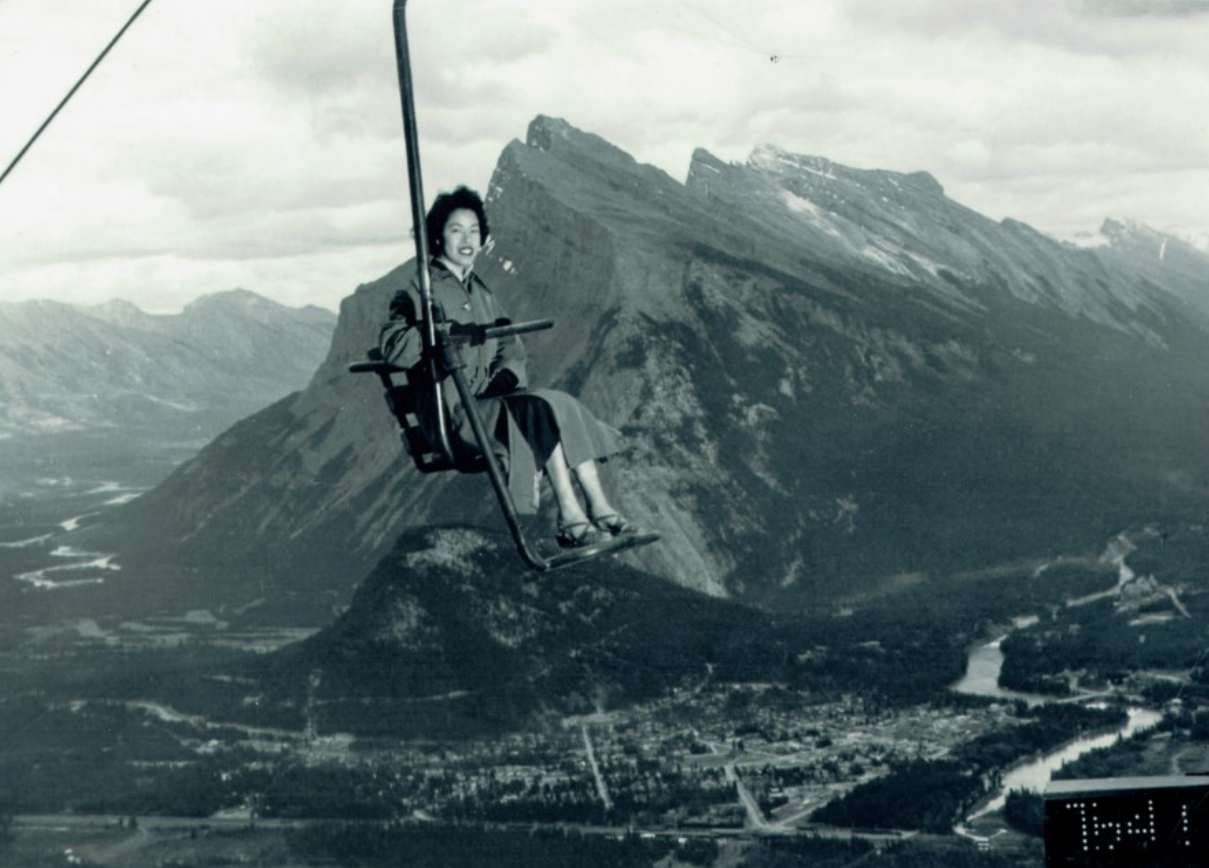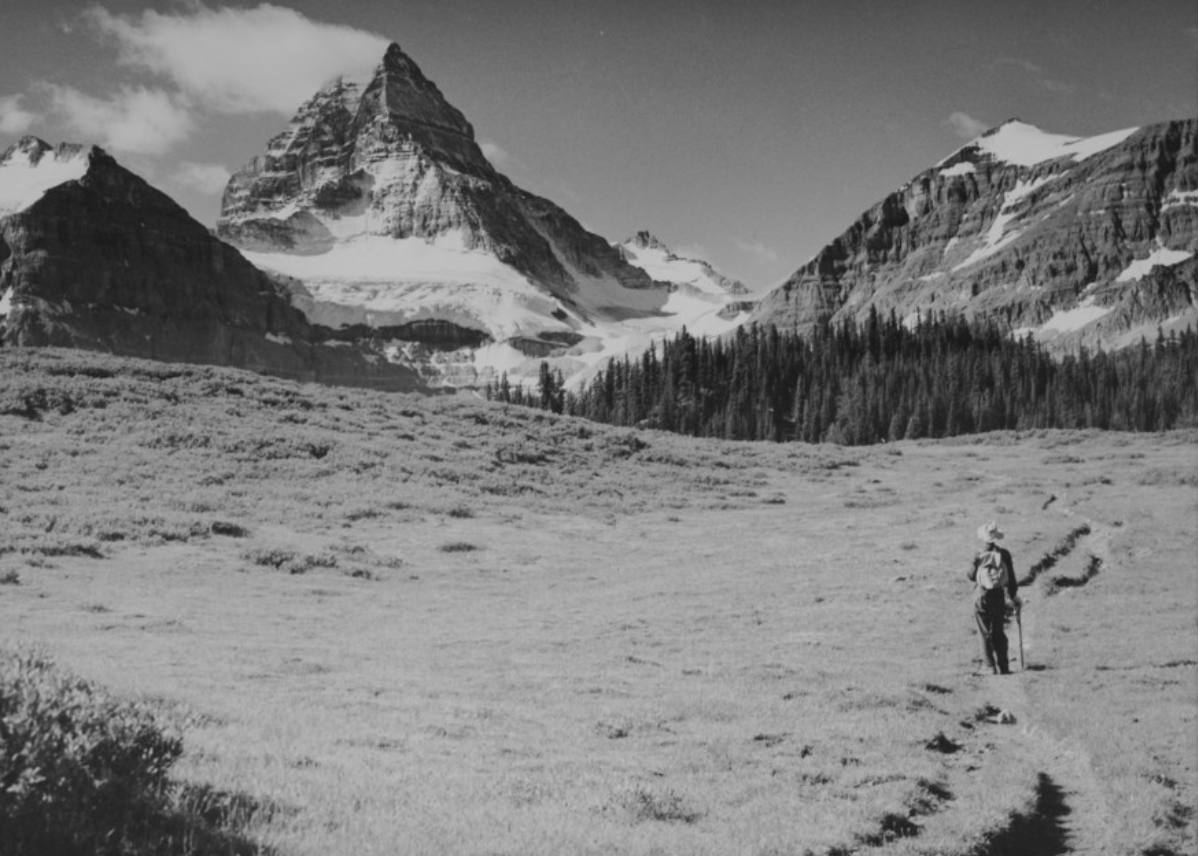
 Bess Louie Rides the Mount Norquay Gondola in Banff in the 1950's Bill Louie Hikes the Og Pass with Mount Assiniboine in the Distance in the late 1950's.
Bess Louie Rides the Mount Norquay Gondola in Banff in the 1950's Bill Louie Hikes the Og Pass with Mount Assiniboine in the Distance in the late 1950's.
Calgary Author Honors Legacy of Early Chinese Immigrants in Bow Valley
Rocky Mountain Outlook
Leah Pelletier
CANMORE — Over 100 years ago, during the height of coal mining operations, the ghost town of Bankhead was alive and well.
Now ruins and remnants, the town on the outskirts of Banff was home to workers from all backgrounds, including many who had made the long journey overseas from China to Canada.
In her new book Honoring the Gold Mountain Dreamers, writer Jacqueline Louie explores the 100 years following the 1923 Chinese Immigration Act, recounting the story of Bankhead family the Chows, alongside the experiences of many other early Chinese immigrants.
“Mr. Chow was the head of the Chinese laborers in Bankhead in the early 20th Century and so his story is unusual, just like all the other families in my book because he was able to have his wife here and they had a family in Canada,” said Louie.
“Mr. Chow was the head of the Chinese laborers in Bankhead in the early 20th Century and so his story is unusual, just like all the other families in my book because he was able to have his wife here and they had a family in Canada,” said Louie.
“There’s a portrait of the whole family at the Whyte Museum.”
Implemented in 1923, the Chinese Immigration Act (also known as the exclusion act), placed a head tax on the Chinese, making it very difficult for them to come to Canada.
This meant it was primarily men who came north to Canada or what the Chinese called “Gold Mountain” because of the mid-19th century gold rush, according to Louie.
“From 1923 to 1947, only 44 immigrants from China were allowed into Canada for almost a quarter century, so it was a very effective act,” said Louie.
Weaving hours of research and interviews with historians and descendants of early immigrants, Louie paints a picture of what life was like for people of Chinese descent.
For many, like the Chow family, it was a time of intense discrimination and hardship.
“Mrs. Chow found the racism at the time extremely difficult, so when the children were still very small she took them back to China and Mr. Chow stayed in Canada, in Bankhead, and he worked to support the family,” said Louie.
The Calgary-based writer highlights how diverse experiences were amongst early immigrants, diving deeper into her own family story through interviews with relatives.
“My father was a grandchild of immigrants to Canada, so when my father was growing up the laws started to change and society started to change and so opportunities started to open up to people of Chinese descent,” she said.
“By the time he was a young man, he was able to get an education. … He went to the University of Alberta and graduated from medicine.”
Louie noted her father went on to serve as a camp doctor on several Alpine Club of Canada expeditions.
“[My father] was a team doctor for an …. expedition to Mount Aconcagua in the Andes and then he was a member of the Alpine Club of Canada in the 1967 Yukon Alpine Centennial Expedition,” she said.
“He just said they were always egalitarian, warm and welcoming, so he was accepted.”
For her mother’s family growing up as the only Chinese family in small town central Alberta presented challenges, said Louie.
“By the time [my mother] came along, things were changing, and it was better and so she didn't have the same experience [as her siblings],” said Louie.
“It’s a world that nobody knows anymore because things have changed so much.”
While hardship and racism marked the lives of many of these early families, Louie looks not only at the darkness of those days but also the contributions, grit and perseverance of early Chinese Canadians.
“One thing that I hope comes across is that the Chinese have integrated very well into Canada and that I'd say most of them, if not all of them, consider themselves to be very proud Canadians,” said Louie.
Touching on the service of Chinese immigrants throughout the Second World War, Louie focuses on the martial arts as a major area of their contribution to Canada.
“It's supposed to be very hopeful and positive because when things changed, then they were able to take advantage of opportunities and get an education and so life did become better. It took a while, and it took a lot of effort.”
Louie added that this piece of Canadian history has, in many ways, fallen through the cracks.
“Catherine Clement talks about this quite a bit in her … book The Paper Trail. She said that in one generation the story was forgotten, and she says it was because it was so painful and dark that the people who lived through it did not talk about it, so after 1947 a lot of these Chinese immigration certificates were burned,” Louie said.
“As a result, their children and grandchildren knew practically nothing. … and that's pretty universal across Canada, I think.”
Writing several historical blogs as a guest author for Canmore's Bear and Bison Inn through the years, Louie said doing a piece on the history of Ha Ling Peak became a spark for writing the book and exploring the contributions of early Chinese immigrants across the country.
Securing a City of Calgary microgrant on the centenary of the Chinese Immigration Act allowed Louie to dive into the project and bring her first book to life.
“As Catherine Clement says, this is Canadian history. It's not just for this one group and hopefully it will give a greater understanding of Canada and where we've come from,” she said.
Attending an author reading at the Canmore Library, Louie will discuss Honoring the Gold Mountain Dreamers during a presentation on Oct. 9.
Canmore climber and writer Jerry Auld will also join for a panel discussion on his theories and research on Ha Ling Peak.
Honoring the Gold Mountain Dreamers is available for purchase at Cafe Books in Canmore and the Whyte Museum Gift Shop in Banff.